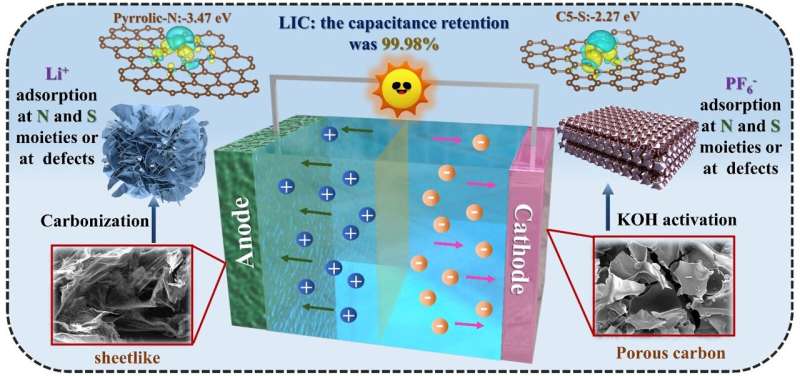This article has been reviewed according to Science X's editorial process and policies. Editors have highlighted the following attributes while ensuring the content's credibility:
fact-checked
proofread
Advancing heteroatom-doped porous carbon nanomaterials for lithium-based energy storage applications

The portable and electric energy storage market has long been dominated by lithium-ion batteries (LIBs) and supercapacitors, surpassing other energy storage systems in their ability to provide higher energy and power.
However, in critical applications such as electric vehicles, there is a growing demand for a device that can efficiently produce both high power and high energy over a significant number of cycles. Meeting these rigorous standards presents new challenges for existing technologies, prompting researchers to explore alternative technologies for energy storage devices.
A promising strategy is to modify the high-conductive hard carbon anode, which exhibits excellent structural stability, to match it with an activated carbon cathode, thus creating a dual-carbon LIC (lithium-ion capacitor). In a recent study, a one-pot in-situ expansion and heteroatom doping strategy was employed to prepare sheet-like hard carbon, while the activated carbon was obtained through activation processes.
"However, ion kinetics mismatch between cathode and anode can lead to unsatisfied cycling lifetime and anode degradation," explained Yingxiong Wang, corresponding of a new study that addressed this limitation. "We used a special method to create two types of carbon materials: sheet-like hard carbon and activated carbon."
Wang and his co-workers used ammonium persulfate to help expand and modify the hard carbon, making it better for use in batteries. The carbon materials, known as FRNS-HC and FRNS-AC, were made from furfural residues, which are leftovers from a natural substance. They were then tested in LIBs.
"The results were impressive—when FRNS-HC was used as the negative part of the battery, it could store 374 mAh g-1 at low power level, and 123.1 mAh g-1 at a higher power level," said Wang. "When combined with a special porous carbon material as the positive part of the battery, the whole battery showed a high specific energy of 147.67 Wh kg-1, with a power output of about 199.93 W kg-1."
Notably, the battery also lasted a very long time, with almost no loss in performance even after being charged and discharged 1,000 times. The team published their findings in Green Energy & Environment.
"We recommend the use of biomass-based raw materials as carbon precursors, along with efficient and eco-friendly synthesis techniques," said Wang. "This study offers a promising approach to create heteroatom-doped porous carbon from biomass waste, and it holds great potential for advancing high-energy-density devices."
More information: Xiaoying Guo et al, Furfural residues derived nitrogen-sulfur co-doped sheet-like carbon: An excellent electrode for dual carbon lithium-ion capacitors, Green Energy & Environment (2023). DOI: 10.1016/j.gee.2023.05.007
Provided by KeAi Communications Co.



















